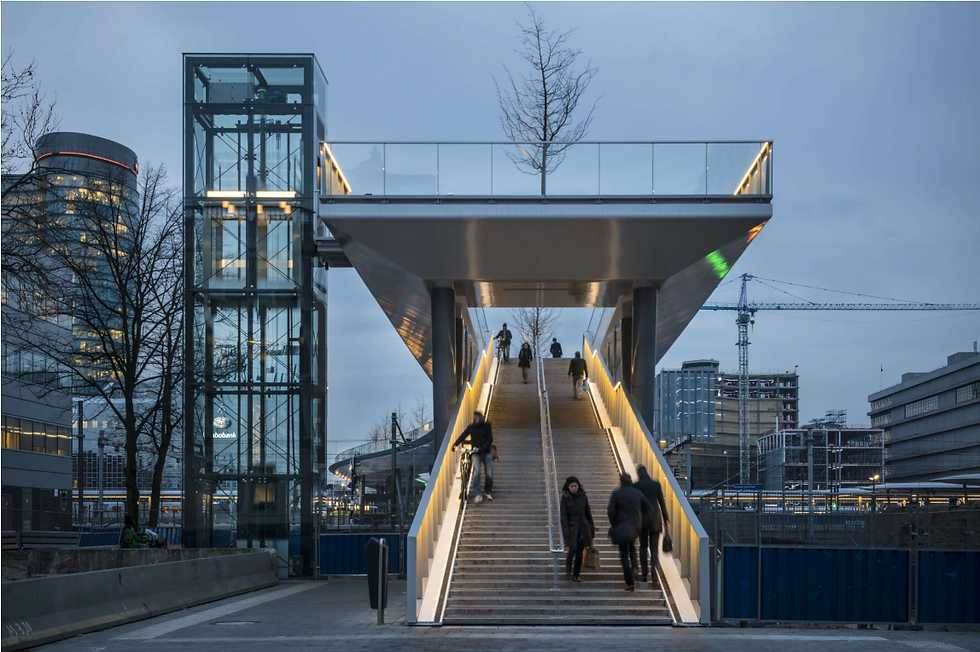Hei brennt de lamp ('the lamp burns here')
- TOPOS

- Apr 25, 2023
- 3 min read
Updated: May 11, 2023

Column by Wim Bosschaart
Several Dutch cities are experiencing a revival, often to transform from former industrial cities into postmodern cities. Well-known examples are Eindhoven (Strijp-S), Tilburg (Spoorzone) or Nijmegen (Honig/Nyma). An often overlooked city that is about to revive is the former coal-mining capital Heerlen in the south of the Netherlands. Heerlen experienced an unpreceded heyday but equally dark periods. Where the light of mine industry diminished over the last decades, the light is now flickering again, as the light at the end of a dark tunnel (or mine shaft, in this case). How can we ignite the switch? Four lessons from the 'Stadsmakersweek' in Heerlen.
The heyday
Around the end of the 19th century it was coal (or the black gold) that transformed Heerlen from a regional agricultural centre into a renowned city. The increasing employment in the twelve mines rapidly drew workers, craftsman, engineers and their families to Heerlen. The workers (known as koempels) expanded to the north of the coal-transporting railway Sittard-Heerlen-Herzogenrath whereas the civil service and upper-class settled in the south. The architect Peutz and mayor Van Grunsven worked together in expressing Heerlen's new grandeur, designing a series of iconic buildings. The modernistic Shunck-building, better know as 'Glasspalace', is listed as one of the 1.000 most important building of the 20th century. Heerlen was rising into modern times, a self-strengthening positive spiral. During its heyday Heerlen had an allure that was not inferior to the Randstad.
The decline
After closing the last state-owned mine in 1974 (due to the rise of natural gas a fuel) the once bright-shining light diminished. The dependence on coal mines kept the light burning but was in fact a mono-economy. The closing led to unemployment, miners with silicosis ('dust lunges') and other related health issues, drug problems and vacant buildings. Simultaneously, spatial policies urged to relocate essential functions such as hospitals, schools and (larger) shops to the edge of the city. The liveability of the centre, again, received a blow, as did the image of Heerlen. The ambiguity around the coal-mining past, where proud and trauma take turns, resulted in the rigorous demolition of nearly all mining heritage. Heerlen, although it might have lived above its standards, experienced a relapse.
The turning point
But times are changing in the conjuncture of cities. Heerlen is rumbling again, but not from the coal-mining. In 2001 the municipality launched Operatie Hartslag with a zero-tolerance approach towards drug dealers and a generous approach towards drug addicts. Remarkably it was the artist Huisman who, against the odds, gave Heerlen its next impulse with his design for the Maankwartier in 2020. Thereafter, renowned architect Francine Houben (who grew up in Heerlen) gave another impulse, amongst others, with her design for the town hall. Subsequently, Heerlen hosted the Internationale Bauausstellung (IBA) in 2021-2022, sparking another round of initiatives. As a next step, students of the Aachen University can now attend study programs in Heerlen (interestingly, the MSc Transforming City Regions). The increasing housing prices gave Heerlen another pull-factor. The light of life is increasing, albeit somewhat flickering.
The revival
But buildings do not solve problems, as Jan Gehl denotes ('first life, then space and then buildings – the other way around never works'). How to turn this flickering light into a bright shining light again? Four insights to spark the revival from the Stadsmakersweek in Heerlen.
Envision Heerlen and Parkstad in a broader spatial context of the EU-region Maas-Rijn. As such, Heerlen is not a remote border city but the centre of an urban agglomeration with cities as Heerlen, Maastricht, Liège and Aachen;
Undo the story of Heerlen from the dust that covers it, stretching from the early settlement between two creeks, the Roman era (with the oldest existing building of the Netherlands, the thermal baths) to the medieval settlement and the mines of the Industrial Revolution;
Explore new sense-making narratives to add new layers to the story of Heerlen (f.e. Heerlen as city of energy, engineering, crafts, daring architecture, etc.) and to create a framework wherein people can evolve, without convulsively forcing stories on people.
Dare to make decisions (together) on what to be and what not and support often general ambitions with concrete guiding principles (f.e. '30% less stone coverage' instead of 'more green')
After all, a revival can only succeed if the social reality transcends along: cities do not change themselves, people (and their ideas) change it, and ignite and sustain the light.
Reference figure:
Wismans. (1975). Oranje-Nassaumijn I. Rijckheyt, Centrum Voor Regionale Geschiedenis. https://proxy.archieven.nl/62/F80A579DADFF5AE6E044001A4B08D326 (CC BY 4.0)







Comments